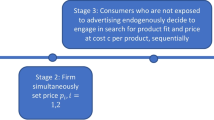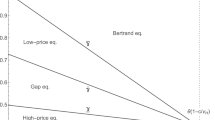Abstract
We develop optimal normative policies for pricing and advertising of products with limited availability by including the traditional product diffusion parameters (Bass, 1969)–innovation and imitation, and the scarcity effects generated due to limited product availability (Swami and Khairnar, 2003). Using optimal control methodology, our pricing policy results suggest that a profit-maximizing firm gradually increases the price as the sales approach the product availability. The optimal normative advertising policy recommends gradually decreasing the expenditure on the awareness advertising and increasing the expenditure on the availability advertising as the product diffusion progresses. These results are illustrated with suitable numerical examples.
Similar content being viewed by others
References
Bass, Frank M. (1969). “A New Product Growth Model for Consumer Durables,” Management Science 15 215–227.
Bayus, B.L. (1994). “Optimal Pricing and Product Development Policies for New Consumer Durables,” International Journal of Research in Marketing 11, 249–259.
Cialdini, Robert B. (1985). Influence: Science and practice Glenview, IL: Scott, Foresman.
Dockner, E. and S. Jorgensen. (1988). “Optimal Advertising Policies for Diffusion Models of New Product Innovation in Monopolistic Situations,” Management Science 34(1), 119–130.
Feng, Y. and G. Gallego. (1995). “Optimal Starting Times and End-of-Season Sales and Optimal Stopping Times for Promotional Fares,” Management Science 41 (8), 1371–1391.
Gallego, G. and van Ryzin. (1994). “Optimal Dynamic Pricing of Inventories with Stochastic Demand Over Finite Horizons,” Management Science 40 (8), 999–1020.
Ho, Tech-Hua, Sergei Savin, and Christian Terwiesch. (2002). “Modeling Demand and Supply Dynamics in Constrained New Product Diffusion Under Supply Constraint,” Management Science 48 (2), 187–206.
Horsky, D. and L.S. Simon. (1983). “Advertising and the Diffusion of New Products,” Marketing Science 2 (Winter), 1–18.
Inman, J. J., Anil C. Peter, and Priya Raghubir. (1997). “Framing the Deal: The Role of Restrictions in Accentuating Deal Value,” Journal of Consumer Research 24 (June), 68–79.
Jain, Dipak, Vijay Mahajan, and Eitan Muller. (1991). “Innovation Diffusion in the Presence of Supply Restrictions,” Marketing Science 10 (1), 83–90.
Kamien, M. and N. Schwartz. (1981). Dynamic Optimization: The Calculus of Variations and Optimal Control Theory in Economics and Management. Amsterdam: North-Holland.
Khairnar, Pankaj. (2000). “Product Diffusion under Conditions of Scarcity: Modeling, Analysis, and Applications,” Unpublished Masters Thesis, Dep. of Industrial & Management Engineering, IIT, Kanpur.
Kotler, Philip. (2000). Marketing Management: The Millennium Edition, Prentice Hall: New Delhi.
Mahajan, V. and E. Muller. (1986). “Advertising Pulsing Policies for Generating Awareness for New Products,” Marketing Science 5 (2), 86–106.
Sethi, S.P. and G.L. Thompson. (2000). Optimal Control Theory: Applications to Management Science and Economics, Second Edition, Kluwer Academic Publishers, Boston, 2000.
Simon, Hermann. (1982). “ADPULS: An Advertising Model with Wearout and Pulsation,” Journal of Marketing Research 19 (August), 352–363.
Simon, Herman and Karl-Heinz Sebastian. (1987). “Diffusion and Advertising: The German Telephone Company,” Management Science 33 (April), 451–466.
Swami, Sanjeev and Pankaj Khairnar. (2003). “Diffusion of Products with Limited Supply and Known Expiration Date,” Marketing Letters 14 (1), 33–46.
Vidale, M.L. and H.B. Wolfe. (1957). “An Operations Research Study of Sales Response to Advertising,” Operations Research 5 (3), 370–381.
Weatherford, L.R. and S.E. Bodily. (1992). “A Taxonomy and Research Overview of Perishable-Asset Revenue Management: Yield Management, Overbooking and Pricing,” Operations Research 40 (5), 831–844.
Author information
Authors and Affiliations
Corresponding author
Rights and permissions
About this article
Cite this article
Swami, S., Khairnar, P.J. Optimal normative policies for marketing of products with limited availability. Ann Oper Res 143, 107–121 (2006). https://doi.org/10.1007/s10479-006-7375-0
Issue Date:
DOI: https://doi.org/10.1007/s10479-006-7375-0




